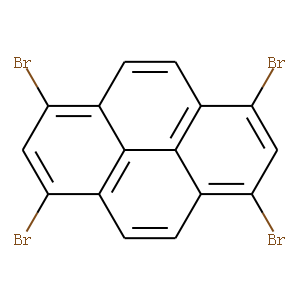| Reference | [1]. Org Lett. 2010 Aug 6;12(15):3292-5. doi: 10.1021/ol1007179.<br />
1,3,6,8-tetrasubstituted pyrenes: solution-processable materials for application in organic electronics.<br />
Sonar P(1), Soh MS, Cheng YH, Henssler JT, Sellinger A.<br />
Author information: (1)Institute of Materials Research and Engineering (IMRE), Agency for Science, Technology and Research (ASTAR), 3 Research Link, Republic of Singapore 117602. [email protected]<br />
A series of star-shaped organic semiconductors have been synthesized from 1,3,6,8-tetrabromopyrene. The materials are soluble in common organic solvents allowing for solution processing of devices such as light-emitting diodes (OLEDs). One of the materials, 1,3,6,8-tetrakis(4-butoxyphenyl)pyrene, has been used as the active emitting layer in simple solution-processed OLEDs with deep blue emission (CIE = 0.15, 0.18) and maximum efficiencies and brightness levels of 2.56 cd/A and >5000 cd/m(2), respectively.<br />
DOI: 10.1021/ol1007179 PMID: 20586440<br />
<br />
[2]. Chemistry. 2016 Apr 18;22(17):5937-44. doi: 10.1002/chem.201504946. Epub 2016 Feb 16.<br />
Comparing Ullmann Coupling on Noble Metal Surfaces: On-Surface Polymerization of 1,3,6,8-Tetrabromopyrene on Cu(111) and Au(111).<br />
Pham TA(1), Song F(2), Nguyen MT(3), Li Z(4), Studener F(2), Stöhr M(5).<br />
Author information: (1)Zernike Institute for Advanced Materials, University of Groningen, Nijenborgh 4, 9747 AG, Groningen, The Netherlands. [email protected]. (2)Zernike Institute for Advanced Materials, University of Groningen, Nijenborgh 4, 9747 AG, Groningen, The Netherlands. (3)The Abdus Salam International Centre for Theoretical Physics, Strada Costiera, 11, 34151, Trieste, Italy. (4)ISA, Department of Physics and Astronomy, University of Aarhus, 8000, Aarhus C, Denmark. (5)Zernike Institute for Advanced Materials, University of Groningen, Nijenborgh 4, 9747 AG, Groningen, The Netherlands. [email protected].<br />
The on-surface polymerization of 1,3,6,8-tetrabromopyrene (Br4 Py) on Cu(111) and Au(111) surfaces under ultrahigh vacuum conditions was investigated by a combination of scanning tunneling microscopy (STM), X-ray photoelectron spectroscopy (XPS) and density functional theory (DFT) calculations. Deposition of Br4 Py on Cu(111) held at 300 K resulted in a spontaneous debromination reaction, generating the formation of a branched coordination polymer network stabilized by C-Cu-C bonds. After annealing at 473 K, the C-Cu-C bonds were converted to covalent C-C bonds, leading to the formation of a covalently linked molecular network of short oligomers. In contrast, highly ordered self-assembled two-dimensional (2D) patterns stabilized by both Br-Br halogen and Br-H hydrogen bonds were observed upon deposition of Br4 Py on Au(111) held at 300 K. Subsequent annealing of the sample at 473 K led to a dissociation of the C-Br bonds and the formation of disordered metal-coordinated molecular networks. Further annealing at 573 K resulted in the formation of covalently linked disordered networks. Importantly, we found that the chosen substrate not only plays an important role as catalyst for the Ullmann reaction, but also influences the formation of different types of intermolecular bonds and thus, determines the final polymer network morphology. DFT calculations further support our experimental findings obtained by STM and XPS and add complementary information on the reaction pathway of Br4 Py on the different substrates.<br />
DOI: 10.1002/chem.201504946 PMID: 26879625<br />
<br />
[3]. Inorg Chem. 2010 Sep 20;49(18):8347-50. doi: 10.1021/ic100857y.<br />
Electronic coupling between two cyclometalated ruthenium centers bridged by 1,3,6,8-tetra(2-pyridyl)pyrene (tppyr).<br />
Yao CJ(1), Sui LZ, Xie HY, Xiao WJ, Zhong YW, Yao J.<br />
Author information: (1)Beijing National Laboratory for Molecular Sciences, Institute of Chemistry, Chinese Academy of Sciences, Beijing 100190, PR China.<br />
A new cyclometalating bridging ligand 1,3,6,8-tetra(2-pyridyl)pyrene was designed and synthesized through 4-fold Suzuki couplings between 1,3,6,8-tetrabromopyrene and 2-pyridylboronate. A bis-cyclometalated bisruthenium complex bridged by this ligand showed the presence of an electronic coupling between individual metal centers, as indicated by electrochemical and spectroscopic studies.<br />
DOI: 10.1021/ic100857y PMID: 20734995<br />
<br />
[4]. Chemistry. 2016 Sep 26;22(40):14319-27. doi: 10.1002/chem.201602688. Epub 2016 Aug 17.<br />
Fluorescence-Tuned Polyhedral Oligomeric Silsesquioxane-Based Porous Polymers.<br />
Wang D(1)(2), Feng S(3)(4), Liu H(5).<br />
Author information: (1)National Engineering Technology Research Center for Colloidal Materials, Shandong University, Jinan, P.R. China. [email protected]. (2)Key Laboratory of Special Functional Aggregated Materials, Ministry of Education, School of Chemistry and Chemical Engineering, Shandong University, Jinan, P.R. China. [email protected]. (3)National Engineering Technology Research Center for Colloidal Materials, Shandong University, Jinan, P.R. China. [email protected]. (4)Key Laboratory of Special Functional Aggregated Materials, Ministry of Education, School of Chemistry and Chemical Engineering, Shandong University, Jinan, P.R. China. [email protected]. (5)Key Laboratory of Special Functional Aggregated Materials, Ministry of Education, School of Chemistry and Chemical Engineering, Shandong University, Jinan, P.R. China. [email protected].<br />
Two series of new polyhedral oligomeric silsesquioxane (POSS)-based fluorescent hybrid porous polymers, HPP-1 and HPP-2, have been prepared by the Heck reaction of octavinylsilsesquioxane with 2,2',7,7'-tetrabromo-9,9'-spirobifluorene and 1,3,6,8-tetrabromopyrene, respectively. Three sets of reaction conditions were employed to assess their effect on fluorescence. These materials exhibit tunable fluorescence from nearly no fluorescence to bright fluorescence both in the solid state and dispersed in ethanol under UV light irradiation by simply altering the reaction conditions. We speculated that the difference may be attributable to the fluorescence quenching induced by Et3 N, P(o-CH3 Ph)3 , and their hydrogen bromide salts employed in the reactions. This finding could give valuable suggestions for the construction of porous polymers with tunable/controllable fluorescence, especially those prepared by Heck and Sonogashira reactions in which these quenchers are used as organic bases or co-catalysts. In addition, the porosities can also be tuned, but different trends in porosity have been found in these two series of polymers, which suggests that various factors should be carefully considered in the preparation of porous polymers with tunable/controllable porosity. Furthermore, HPP-1 c showed moderate CO2 uptake and fluorescence that was efficiently quenched by nitroaromatic explosives, thereby indicating that these materials could be utilized as solid absorbents for the capture and storage of CO2 and as sensing agents for the detection of explosives.<br />
DOI: 10.1002/chem.201602688 PMID: 27533795
|

